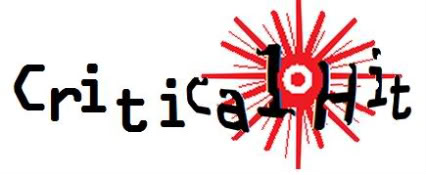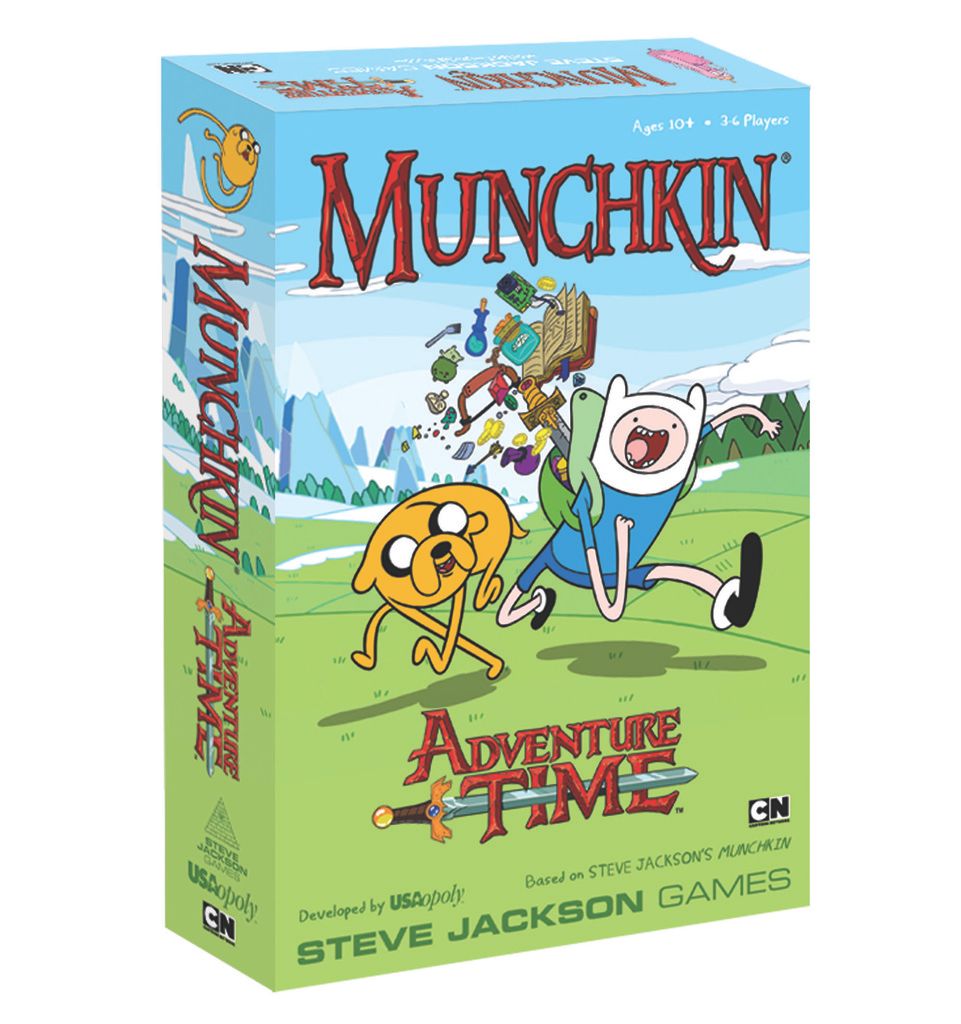RRP £19.99
Game provided by the distributor
If you already know Munchkin, this is a nice easy review; it’s Munchkin but Adventure Time flavoured. If you don’t already know Munchkin… damn, I have to do this properly.
Adventure Time Munchkin is a tabletop role playing game which involves cards, a dice, treasure, fighting monsters, and sentences like “-6 against WIZARDS”. Don’t worry, though – cloaks and silly hats round the table are entirely optional. In fact, it’s not as demanding or nerdy as tabletop games can be (or, at least, as you may imagine them); but if this is your first experience of such a game, it can certainly be very daunting initially. The instruction pamphlet is infused with a healthy dose of Adventure Time style humour, and the fonts and layout are very evocative of the show. Unfortunately, when it comes to doing its actual job of explaining the game, it’s a bit crap. The whole construction of the explanations needs a bit of a reshuffle, and there are unanswered questions even if you carefully read the whole thing from start to finish. The instructions on their own explain perhaps 80% of the experience and, if you’re unfamiliar with Munchkin, the only way to sniff out the other 20% is by starting your first game and referring to the iffy instructions ever 30 seconds.
In the box you get a bunch of Treasure cards, a bunch of Door cards, a dice (with Jake’s face in place of the number one, which is a neat touch), and eight character cards – one for each player up to a maximum of, er, six. The characters you can be are, in full: Finn, Jake, Marceline, Princess Bubblegum, Flame Princess, Lady Rainicorn, Lumpy Space Princess, and BMO. Cards are (supposed to be) assigned randomly, and you’re (supposed) to assume the gender that matches you. Each character therefore has its gender-swapped version on the other side of the card, as handily pre-prepared by the Ice King’s fanfiction. Apart from BMO because, well… BMO is BMO. Both versions of each character share permanent bonuses that apply throughout the game. For example, Marceline/Marshall Lee gets a +2 bonus against any monster with the colour red on it, and a +2 bonus if she/he has a musical instrument equipped.

“Ha-ha, I’m a dice!”
+2, you may be asking yourself, before sheepishly realising that you said that out loud. What on earth is this chap on about? Well, monster fights work like this: each monster has a level, which can sometimes increase or decrease depending on certain factors. For example, Goliad is level 14; but suffers a -5 penalty against players level 5 or below, but a +5 bonus against players level 6 or above. These factors can leak into the real world too, such as with Bucket Knight (he’s only level 4, but gets a +8 bonus if there’s a drink anywhere on the table). As for you, puny human, your combat strength is your level plus any bonuses afforded by weapon, armour, or ally cards that you have in play. If your strength is higher than that of the monster, you win.
Before going back to combat, I’ll give you the briefest overview of how the game works. I’m not going to go into great detail. It’s actually an easy game to follow once you get the hang of it, but on paper it looks hideously complicated and, yes, I do realise that this means whoever was lumbered with the task of writing the instructions had an uphill struggle. At the start of the game, each player gets four door cards and four treasure cards, with the rest in the middle of the table. Each player, at the beginning of their turn, turns over the top Door card. If it’s a monster, they must fight it; if it’s a Curse, the effect (such as losing two levels, discarding the item giving you the biggest bonus, or being unable to use any items in your next fight) applies to you immediately. If it’s any other card, you keep it and then either draw another Door card to keep for later use (even a monster or Curse), or fight a monster if you have a monster card in your deck.
You start at level 1, and can not drop below this level. The object of the game is to be the first to reach level 10. The only way to level up is to fight and defeat a monster, or by playing one of the few Treasure cards which allows you to instantly level up. You can only hit the final level by winning a fight. Okay, so; you’re fighting a monster, and find that your combat strength is equal to theirs. What now? The same as if your level is lower; you must attempt to Run Away. Roll the dice; roll a 5 or a 6, and you are successful. Anything else and you fail to escape, and the Bad Stuff on the monster card happens to you. This could be anything from a minor irritation (lose a specific card) to a mild irritation (lose a level or two) to a hair-pulling wail-inducing frustration (death – which means losing all your stuff, but allows you to resurrect on the next turn and limp along weakened).

They don’t really shine with awesomeness; that’s just my camera flash.
However – and this is where things get even more interesting – the other players don’t cease to exist while you’re in the middle of a monster fight. If you’re too weak to win, you can try to convince another player to help you; perhaps by bribing them with a card that they really want, and/or by sharing/giving away the treasure that results from the monster’s defeat. Also however, your relationship with the people you’re playing with will have a huge effect on how the game plays in a way that few other games can claim. Not only because help can be given – but because hindrance can be given, too. Oh boy, can hindrance be given.
If another player is in a fight, and they’re getting dangerously close to level 10 – or somebody has bribed you to make things difficult for that player, or if you don’t like them, or if you simply enjoy being That Person – you (and anybody else who’s playing) can play cards to weaken the player or significantly strengthen the monster. The box advises that you’ll need 1-2 hours for a game but, really, this varies massively depending on how many people are playing and how they choose to play it. This is a game that has the potential to elicit many a swear word; but, y’know, in a good way.
The box also says that it’s a game for 3-6 players, and for ages 10 and up. Well first of all, there are eight character cards; why not make use of all of them?!? I have no idea what an eight player game would be like, mind you, because I don’t have that many friends. Anyway, I also found that, while the game does indeed work best with at least three people, it’s still fun and works with just two. I can confirm that ten is a reasonable minimum age, because my ten year old daughter – a big Adventure Time fan – was more than willing to put in the time to get her head round the rules, and asks to play it on a regular basis. Much to my surprise, however, my six year old daughter also found the dedication and patience to learn the game, and also asks to play it quite a lot. Never underestimate kids!
And me? Hell yeah, I enjoy it too. It’s a great game! In all honesty, I’m still not sure I have a complete and firm grip on every iota of the rules, but we’re all having fun with it; and that’s the most important thing. I also like the fact that, although Munchkin is an existing game that’s been given an Adventure Time lick of paint, the characters, items, and curses have all been lifted directly from the show; and their strengths and weaknesses (mostly) make immediate sense in the context of the scripts. Should Adventure Time fans buy this? Totally, dude! Now hurry up, you’ve got monster butts to kick!




Comments